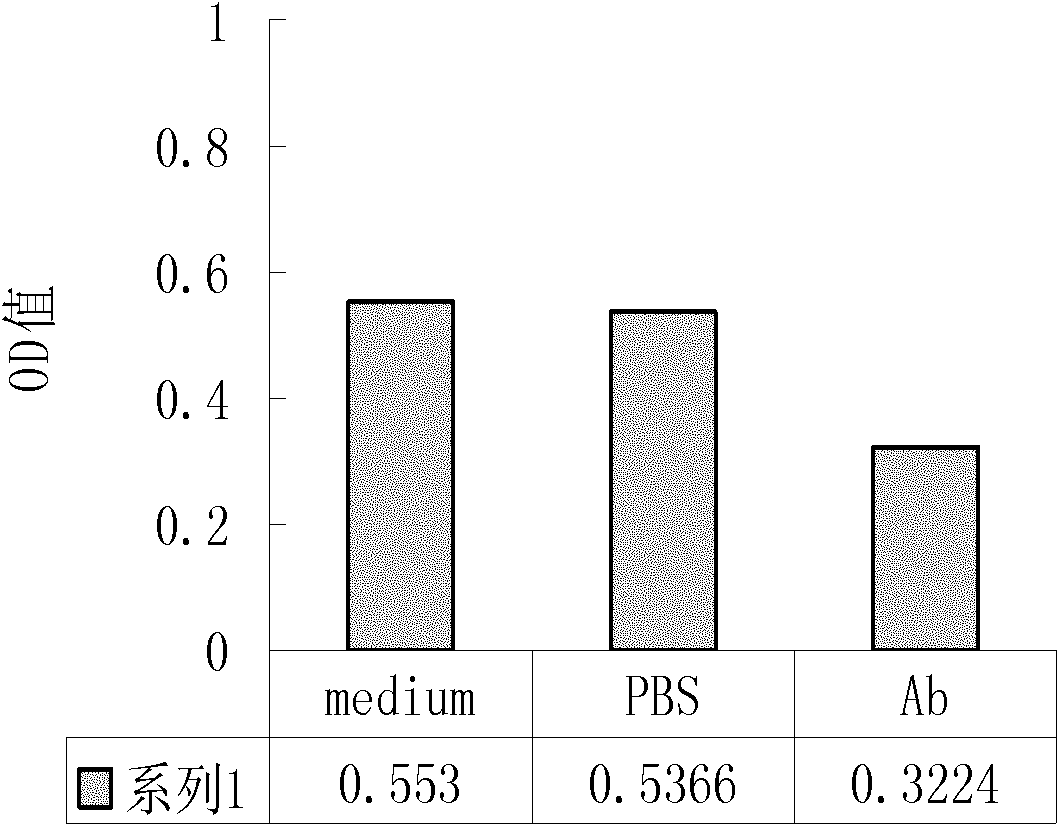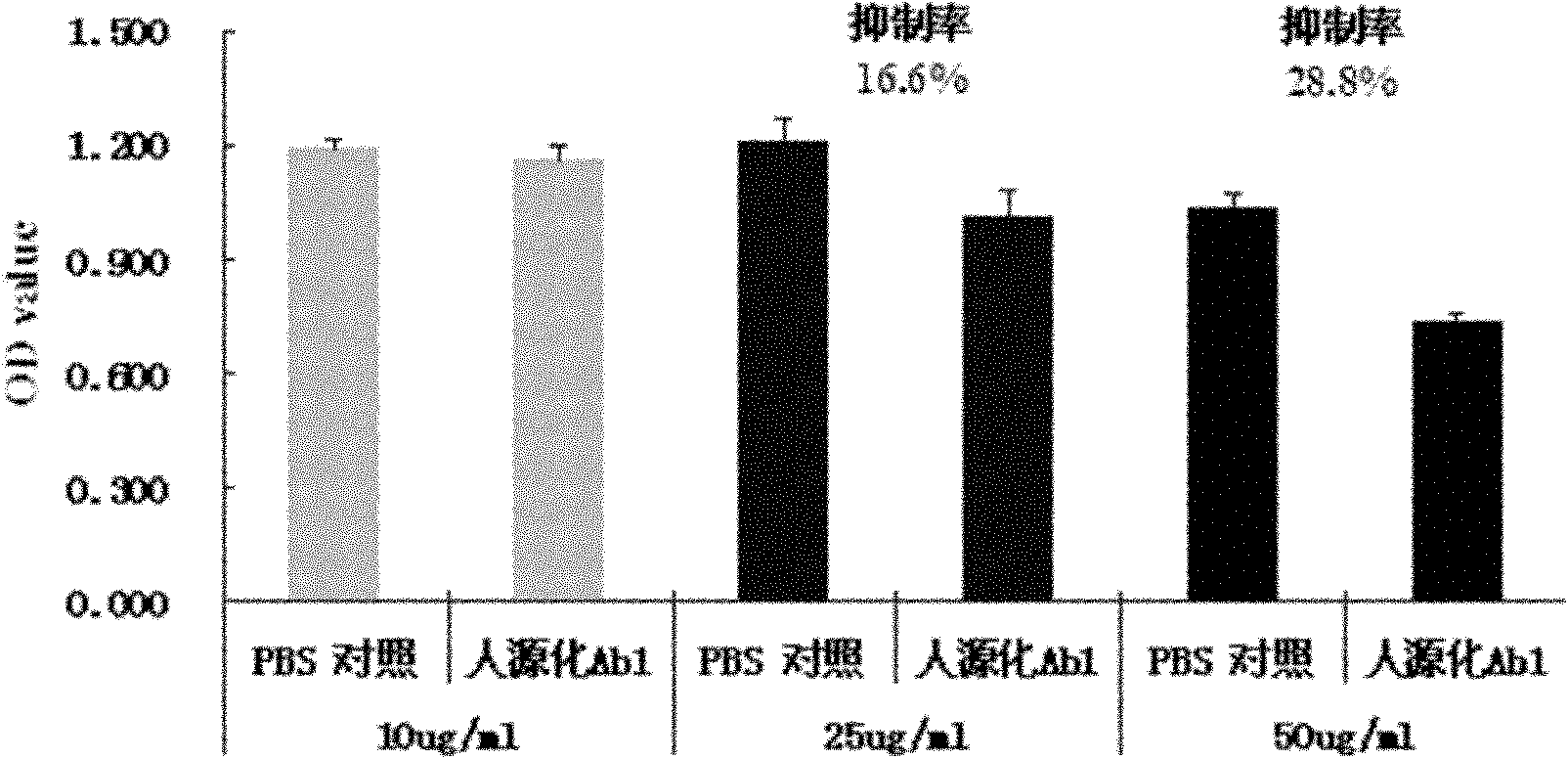Preparation method and use of chimeric human anti-murine monoclonal antibody for inhibiting angiostatin acceptor
A monoclonal antibody, anti-vascular technology, applied in the direction of anti-receptor/cell surface antigen/cell surface determinant immunoglobulin, application, antibody, etc., can solve problems such as mAb limitation and trough, and achieve the effect of inhibiting ATP synthesis
- Summary
- Abstract
- Description
- Claims
- Application Information
AI Technical Summary
Problems solved by technology
Method used
Image
Examples
Embodiment 1
[0037] The preparation of embodiment 1 chimeric antibody
[0038] A hybridoma cell line was obtained by conventional fusion of mouse splenocytes immunized with human ATP synthase antigen and mouse myeloma cells, and a positive clone hybridoma cell line 7E10 was screened out.
[0039] Take positive clone hybridoma 7E10 cell line: 5000-10000 cells, use Trizol (product of Invitrogen Company) to separate total RNA, and use reverse transcriptase (product of Invitrogen Company) to obtain cDNA. The above operations were carried out in accordance with the manufacturer's instructions. PCR was carried out with the following primers and conditions, and the amplicon used was KOD plus (TOYOBO) to ensure that possible mutations were reduced during the amplification process.
[0040] There are 4 sets of amplification primers for the antibody Fab region, respectively mouse IgG-5' / mouse IgG1-3', mouseIgG-5' / mouse IgG2a-3', mouse IgG-5' / mouse IgG3-3', (LCi +LC2+LC3+LC4+LC5+LC6+LC7) / mouse kapp...
Embodiment 2
[0179] Example 2 Anti-tumor effect experiment of anti-angiostatin receptor mouse antibody
[0180] 1. The purpose of the experiment:
[0181] Pharmacodynamic experiment of antitumor activity of 7E10 injection.
[0182] 2. Experimental animals:
[0183] Mice (ICR, 16-21g, male), purchased and pre-raised for 5 days a week before the experiment, were raised in the Experimental Animal Center of Nan Medical University
[0184] Construction of animal model: expand the culture of lung cancer cells A549, inoculate 3 million nude mice subcutaneously, set up high (50mg / kg / time), medium (25mg / kg / time), low (12.5mg / kg / time) Three doses of experimental group and PBS control group and A549 no treatment group.
[0185] 3. Experimental drugs:
[0186] After the 7E10 is obtained through expression and conventional separation and purification, the 7E10 injection is prepared by conventional methods.
[0187] 7E10 injection low dose group: 7E10 concentration is 0.05mg / ml
[0188] 7E10 injec...
Embodiment 3
[0213] Example 3 Effects of Angiostatin Receptor Mouse Antibody on Tumor Cells
[0214] Experimental tumor cells: human lung adenocarcinoma cell line (A549), human highly metastatic lung cancer cell line (95-D)
[0215] 7E10 antibody: the concentration is 100ug / ml, 200ug / ml
[0216] 1. Mouse 7E10 antibody acts on tumor cells to inhibit proliferation
[0217] Experimental steps:
[0218] (1) Collect the logarithmic phase cells, adjust the concentration of the cell suspension, add 100ul to each well, and plate to adjust the density of the cells to be tested to 1000-10000 wells (the edge wells are filled with sterile PBS).
[0219] (2) Incubate at 37°C with 5% CO2 until the cell monolayer covers the bottom of the well (96-well flat bottom plate). / ml, 300ug / ml of 7E10 antibody. Five replicate wells were set up for each concentration.
[0220] (3) 5% CO2, incubate at 37°C for 16-48 hours, observe under an inverted microscope.
[0221] (4) Add 20 ul of MTT solution (5 mg / ml, ...
PUM
 Login to View More
Login to View More Abstract
Description
Claims
Application Information
 Login to View More
Login to View More - R&D
- Intellectual Property
- Life Sciences
- Materials
- Tech Scout
- Unparalleled Data Quality
- Higher Quality Content
- 60% Fewer Hallucinations
Browse by: Latest US Patents, China's latest patents, Technical Efficacy Thesaurus, Application Domain, Technology Topic, Popular Technical Reports.
© 2025 PatSnap. All rights reserved.Legal|Privacy policy|Modern Slavery Act Transparency Statement|Sitemap|About US| Contact US: help@patsnap.com



